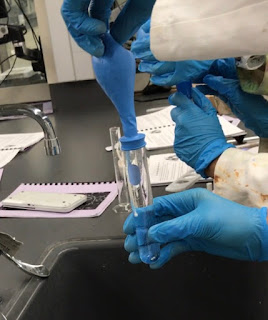Lab 20: Solubility Inquiry Lab

Solubility Inquiry Lab Introduction: The purpose of this lab was to identify the name of an unknown solid by dissolving it in different temperatures of water or dissolving different amounts of the solid. While doing this, we used a solubility curve graph of the three possible solutes which allowed us to determine what specific temperatures or amount of solute to test. Some important terms for this lab include solubility curve, solute, solvent, and saturated/unsaturated solution. A solubility curve is the graph of the maximum amount of a solute that can be dissolved, in 100 grams of water, at different temperatures. A solute is the substance that is being dissolved in the solvent. A solvent is the substance which is dissolving a solute. An example of a solute and solvent would be dissolving sugar in water where the sugar would be the solute and the water would be the solvent. A saturated solution is when there is the maximum amount of solute dissolved in water. A solution is ...





